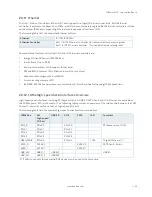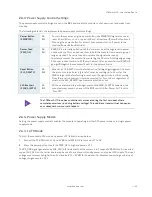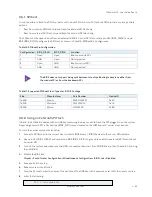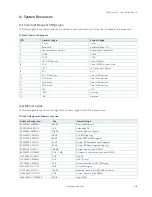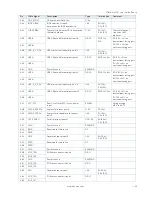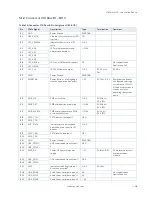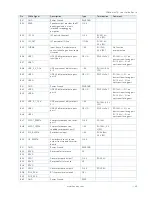
COMe-mAL10 – User Guide, Rev. 1.3
www.kontron.com
// 36
The COMe-mAL10 offers a watchdog that works with two stages that can be programmed independently and used
stage by stage.
Table 18: Dual Staged Watchdog Timer- Time-Out Events
0000b
No action
The stage is off and will be skipped.
0001b
Reset
A reset restarts the module and starts a new POST and operating system.
0101b
Delay ->
No action*
Might be necessary when an operating system must be started and the time for
the first trigger pulse must be extended. Only available in the first stage.
1000b
WDT Only
This setting triggers the WDT pin on the baseboard connector (COM Express®
pin B27) only.
1001b
Reset + WDT
1101b
DELAY + WDT ->
No action*
3.6.1.
Watchdog Timer Signal
Watchdog time-out event (pin B27) on COM Express® connector offers a signal that can be asserted when a
watchdog timer has not been triggered within a set time. The WDT signal is configurable to any of the two stages.
After reset, the signal is automatically deasserted. If deassertion is necessary during runtime, contact Kontron
Support for further help.
3.7.
GPIO
Eight GPIO pins are available, with four pins for the in-direction (pin A54 for GPI0, pin A63 for GPI1, pin A67 for GPI2 and
pin A85 for GPI3) and four pins for the out-direction (pin A93 for GPO0, pin B54 for GPO1, pin B57 for GPO2 and pin B63
for GPO3). The type of termination resistor on the module sets the direction of the GPIO where GPIs are terminated
with pull-up resistors and GPOs are terminated with pull-down resistors.
Due to, the fact that both the pull-up and pull-down termination resistors are weak, it is possible to override the
termination resistors using external pull-ups, pull-downs or IOs. Overriding the termination resistors means that the
eight GPIO pins can be considered as bi-directional since there are no restrictions whether you use the available GPIO
pins in the in-direction or out-direction.
3.8.
Real Time Clock (RTC)
The RTC keeps track of the current time accurately. The RTC’s low power consumption means that the RTC can be
powered from an alternative source of power, enabling the RTC to continue to keep time while the primary source of
power is off or unavailable. The COMe-mAL10’s RTC battery voltage range is 2.8 V - 3.47 V.
3.9.
Trusted Platform Module (TPM 2.0)
A Trusted Platform Module (TPM) stores RSA encryption keys specific to the host system for hardware
authentication. The term TPM refers to the set of specifications applicable to TPM chips. The LPC bus connects the
TPM chip to the CPU.
Each TPM chip contains an RSA key pair called the Endorsement Key (EK). The pair is maintained inside the TPM chip
and cannot be accessed by software. The Storage Root Key (SRK) is created when a user or administrator takes
ownership of the system. This key pair is generated by the TPM based on the Endorsement Key and an owner-
specified password.
A second key, called an Attestation Identity Key (AIK) protects the device against unauthorized firmware and software
modification by hashing critical sections of firmware and software before they are executed. When the system

